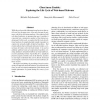Free Online Productivity Tools
i2Speak
i2Symbol
i2OCR
iTex2Img
iWeb2Print
iWeb2Shot
i2Type
iPdf2Split
iPdf2Merge
i2Bopomofo
i2Arabic
i2Style
i2Image
i2PDF
iLatex2Rtf
Sci2ools
NSDI
2008
2008
Ghost Turns Zombie: Exploring the Life Cycle of Web-based Malware
While the web provides information and services that enrich our lives in many ways, it has also become the primary vehicle for delivering malware. Once infected with web-based malware, an unsuspecting user's machine is converted into a productive member of the Internet underground. In this work, we explore the life cycle of webbased malware by employing light-weight responders to capture the network profile of infected machines. Our results indicate that web-based malware provides a cornerstone for large scale electronic fraud. It is used to exfiltrate address books of compromised machines creating databases of hundred millions of email addresses, to form spamming botnets responsible for a significant fraction of spam currently seen on the Internet, and also to steal login credentials that can be directly monetized or leveraged to turn more web servers into malware delivery vectors. We support our findings by providing a broad overview of the post-infection network behavior of we...
| Added | 02 Oct 2010 |
| Updated | 02 Oct 2010 |
| Type | Conference |
| Year | 2008 |
| Where | NSDI |
| Authors | Michalis Polychronakis, Niels Provos |
Comments (0)

